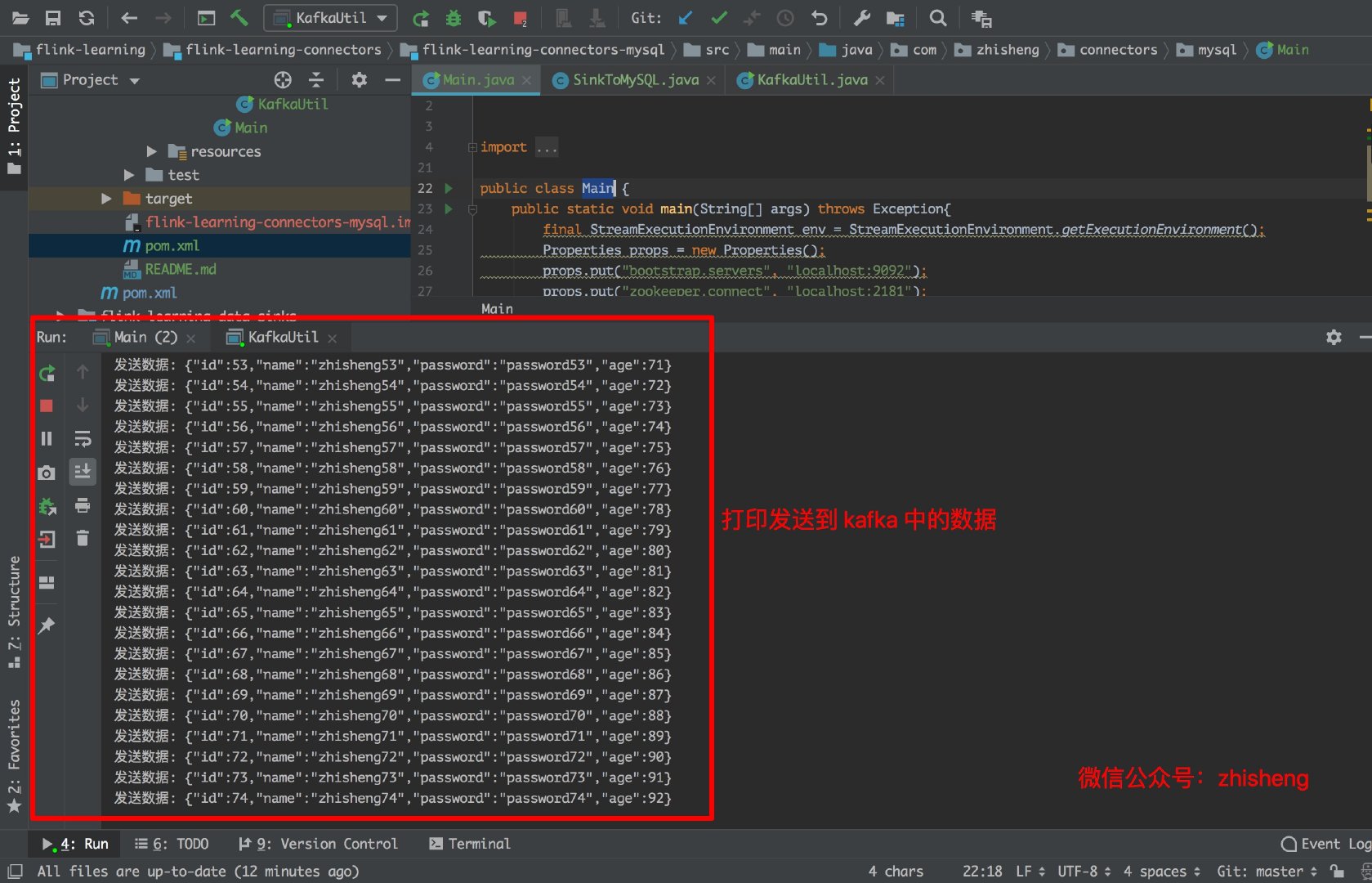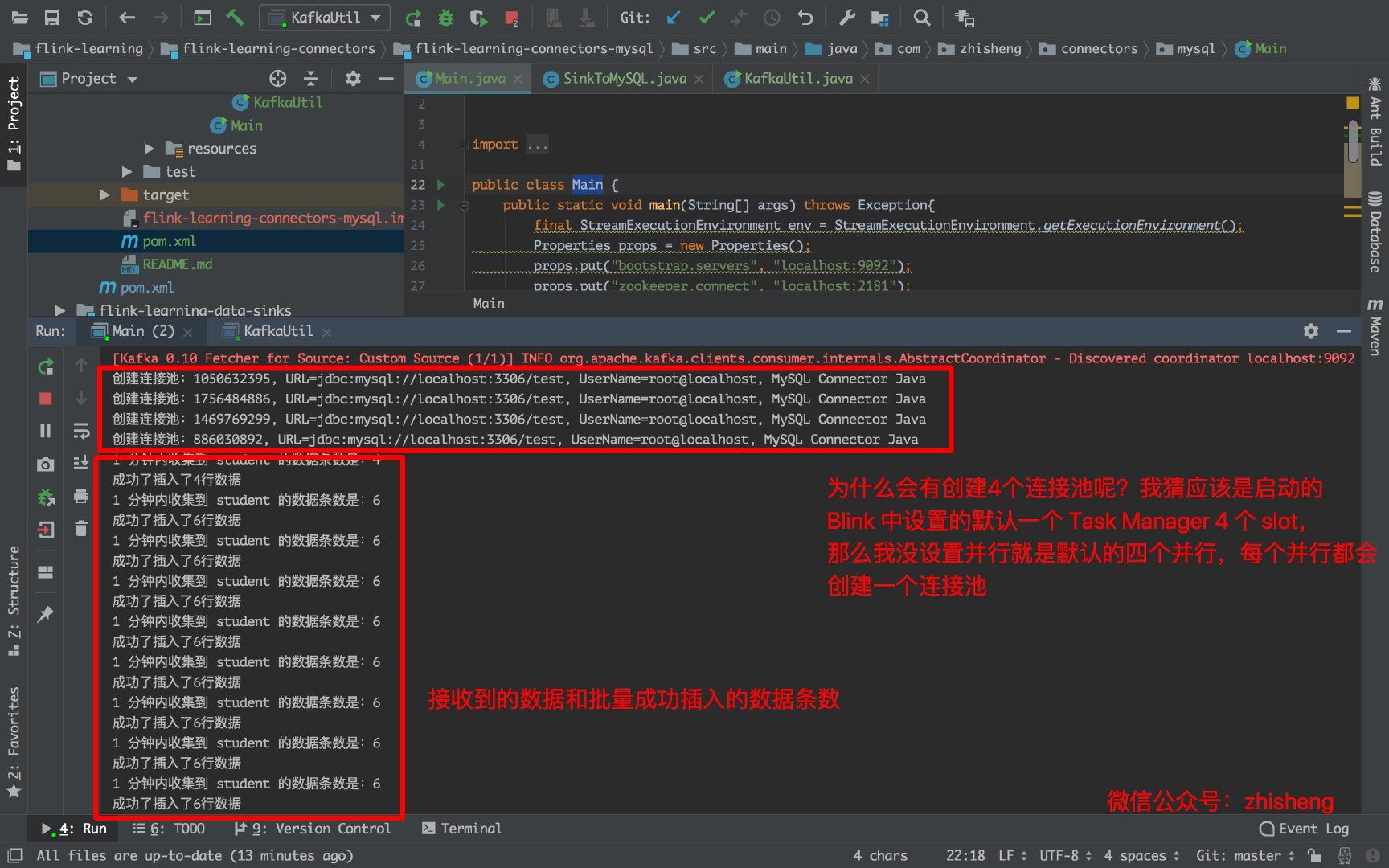前言
之前其实在 《从0到1学习Flink》—— 如何自定义 Data Sink ? 文章中其实已经写了点将数据写入到 MySQL,但是一些配置化的东西当时是写死的,不能够通用,最近知识星球里有朋友叫我: 写个从 kafka 中读取数据,经过 Flink 做个预聚合,然后创建数据库连接池将数据批量写入到 mysql 的例子。
于是才有了这篇文章,更多提问和想要我写的文章可以在知识星球里像我提问,我会根据提问及时回答和尽可能作出文章的修改。
准备
你需要将这两个依赖添加到 pom.xml 中
1
2
3
4
5
|
<dependency>
<groupId>mysql</groupId>
<artifactId>mysql-connector-java</artifactId>
<version>5.1.34</version>
</dependency>
|
读取 kafka 数据
这里我依旧用的以前的 student 类,自己本地起了 kafka 然后造一些测试数据,这里我们测试发送一条数据则 sleep 10s,意味着往 kafka 中一分钟发 6 条数据。
1
2
3
4
5
6
7
8
9
10
11
12
13
14
15
16
17
18
19
20
21
22
23
24
25
26
27
28
29
30
31
32
33
34
35
36
37
38
39
|
package com.zhisheng.connectors.mysql.utils;
import com.zhisheng.common.utils.GsonUtil;
import com.zhisheng.connectors.mysql.model.Student;
import org.apache.kafka.clients.producer.KafkaProducer;
import org.apache.kafka.clients.producer.ProducerRecord;
import java.util.Properties;
public class KafkaUtil {
public static final String broker_list = "localhost:9092";
public static final String topic = "student";
public static void writeToKafka() throws InterruptedException {
Properties props = new Properties();
props.put("bootstrap.servers", broker_list);
props.put("key.serializer", "org.apache.kafka.common.serialization.StringSerializer");
props.put("value.serializer", "org.apache.kafka.common.serialization.StringSerializer");
KafkaProducer producer = new KafkaProducer<String, String>(props);
for (int i = 1; i <= 100; i++) {
Student student = new Student(i, "zhisheng" + i, "password" + i, 18 + i);
ProducerRecord record = new ProducerRecord<String, String>(topic, null, null, GsonUtil.toJson(student));
producer.send(record);
System.out.println("发送数据: " + GsonUtil.toJson(student));
Thread.sleep(10 * 1000);
}
producer.flush();
}
public static void main(String[] args) throws InterruptedException {
writeToKafka();
}
}
|
从 kafka 中读取数据,然后序列化成 student 对象。
1
2
3
4
5
6
7
8
9
10
11
12
13
14
|
final StreamExecutionEnvironment env = StreamExecutionEnvironment.getExecutionEnvironment();
Properties props = new Properties();
props.put("bootstrap.servers", "localhost:9092");
props.put("zookeeper.connect", "localhost:2181");
props.put("group.id", "metric-group");
props.put("key.deserializer", "org.apache.kafka.common.serialization.StringDeserializer");
props.put("value.deserializer", "org.apache.kafka.common.serialization.StringDeserializer");
props.put("auto.offset.reset", "latest");
SingleOutputStreamOperator<Student> student = env.addSource(new FlinkKafkaConsumer011<>(
"student",
new SimpleStringSchema(),
props)).setParallelism(1)
.map(string -> GsonUtil.fromJson(string, Student.class));
|
因为 RichSinkFunction 中如果 sink 一条数据到 mysql 中就会调用 invoke 方法一次,所以如果要实现批量写的话,我们最好在 sink 之前就把数据聚合一下。那这里我们开个一分钟的窗口去聚合 Student 数据。
1
2
3
4
5
6
7
8
9
10
|
student.timeWindowAll(Time.minutes(1)).apply(new AllWindowFunction<Student, List<Student>, TimeWindow>() {
@Override
public void apply(TimeWindow window, Iterable<Student> values, Collector<List<Student>> out) throws Exception {
ArrayList<Student> students = Lists.newArrayList(values);
if (students.size() > 0) {
System.out.println("1 分钟内收集到 student 的数据条数是:" + students.size());
out.collect(students);
}
}
});
|
写入数据库
这里使用 DBCP 连接池连接数据库 mysql,pom.xml 中添加依赖:
1
2
3
4
5
|
<dependency>
<groupId>org.apache.commons</groupId>
<artifactId>commons-dbcp2</artifactId>
<version>2.1.1</version>
</dependency>
|
如果你想使用其他的数据库连接池请加入对应的依赖。
这里将数据写入到 MySQL 中,依旧是和之前文章一样继承 RichSinkFunction 类,重写里面的方法:
1
2
3
4
5
6
7
8
9
10
11
12
13
14
15
16
17
18
19
20
21
22
23
24
25
26
27
28
29
30
31
32
33
34
35
36
37
38
39
40
41
42
43
44
45
46
47
48
49
50
51
52
53
54
55
56
57
58
59
60
61
62
63
64
65
66
67
68
69
70
71
72
73
74
75
76
77
78
79
80
81
82
83
84
85
86
87
88
89
90
91
92
93
|
package com.zhisheng.connectors.mysql.sinks;
import com.zhisheng.connectors.mysql.model.Student;
import org.apache.commons.dbcp2.BasicDataSource;
import org.apache.flink.configuration.Configuration;
import org.apache.flink.streaming.api.functions.sink.RichSinkFunction;
import javax.sql.DataSource;
import java.sql.Connection;
import java.sql.DriverManager;
import java.sql.PreparedStatement;
import java.util.List;
public class SinkToMySQL extends RichSinkFunction<List<Student>> {
PreparedStatement ps;
BasicDataSource dataSource;
private Connection connection;
@Override
public void open(Configuration parameters) throws Exception {
super.open(parameters);
dataSource = new BasicDataSource();
connection = getConnection(dataSource);
String sql = "insert into Student(id, name, password, age) values(?, ?, ?, ?);";
ps = this.connection.prepareStatement(sql);
}
@Override
public void close() throws Exception {
super.close();
if (connection != null) {
connection.close();
}
if (ps != null) {
ps.close();
}
}
@Override
public void invoke(List<Student> value, Context context) throws Exception {
for (Student student : value) {
ps.setInt(1, student.getId());
ps.setString(2, student.getName());
ps.setString(3, student.getPassword());
ps.setInt(4, student.getAge());
ps.addBatch();
}
int[] count = ps.executeBatch();
System.out.println("成功了插入了" + count.length + "行数据");
}
private static Connection getConnection(BasicDataSource dataSource) {
dataSource.setDriverClassName("com.mysql.jdbc.Driver");
dataSource.setUrl("jdbc:mysql://localhost:3306/test");
dataSource.setUsername("root");
dataSource.setPassword("root123456");
dataSource.setInitialSize(10);
dataSource.setMaxTotal(50);
dataSource.setMinIdle(2);
Connection con = null;
try {
con = dataSource.getConnection();
System.out.println("创建连接池:" + con);
} catch (Exception e) {
System.out.println("-----------mysql get connection has exception , msg = " + e.getMessage());
}
return con;
}
}
|
核心类 Main
核心程序如下:
1
2
3
4
5
6
7
8
9
10
11
12
13
14
15
16
17
18
19
20
21
22
23
24
25
26
27
28
29
30
|
public class Main {
public static void main(String[] args) throws Exception{
final StreamExecutionEnvironment env = StreamExecutionEnvironment.getExecutionEnvironment();
Properties props = new Properties();
props.put("bootstrap.servers", "localhost:9092");
props.put("zookeeper.connect", "localhost:2181");
props.put("group.id", "metric-group");
props.put("key.deserializer", "org.apache.kafka.common.serialization.StringDeserializer");
props.put("value.deserializer", "org.apache.kafka.common.serialization.StringDeserializer");
props.put("auto.offset.reset", "latest");
SingleOutputStreamOperator<Student> student = env.addSource(new FlinkKafkaConsumer011<>(
"student",
new SimpleStringSchema(),
props)).setParallelism(1)
.map(string -> GsonUtil.fromJson(string, Student.class));
student.timeWindowAll(Time.minutes(1)).apply(new AllWindowFunction<Student, List<Student>, TimeWindow>() {
@Override
public void apply(TimeWindow window, Iterable<Student> values, Collector<List<Student>> out) throws Exception {
ArrayList<Student> students = Lists.newArrayList(values);
if (students.size() > 0) {
System.out.println("1 分钟内收集到 student 的数据条数是:" + students.size());
out.collect(students);
}
}
}).addSink(new SinkToMySQL());
env.execute("flink learning connectors kafka");
}
}
|
运行项目
运行 Main 类后再运行 KafkaUtils.java 类!
下图是往 Kafka 中发送的数据:

下图是运行 Main 类的日志,会创建 4 个连接池是因为默认的 4 个并行度,你如果在 addSink 这个算子设置并行度为 1 的话就会创建一个连接池:

下图是批量插入数据库的结果:

总结
本文从知识星球一位朋友的疑问来写的,应该都满足了他的条件(批量/数据库连接池/写入mysql),的确网上很多的例子都是简单的 demo 形式,都是单条数据就创建数据库连接插入 MySQL,如果要写的数据量很大的话,会对 MySQL 的写有很大的压力。这也是我之前在 《从0到1学习Flink》—— Flink 写入数据到 ElasticSearch 中,数据写 ES 强调过的,如果要提高性能必定要批量的写。就拿我们现在这篇文章来说,如果数据量大的话,聚合一分钟数据达万条,那么这样批量写会比来一条写一条性能提高不知道有多少。


